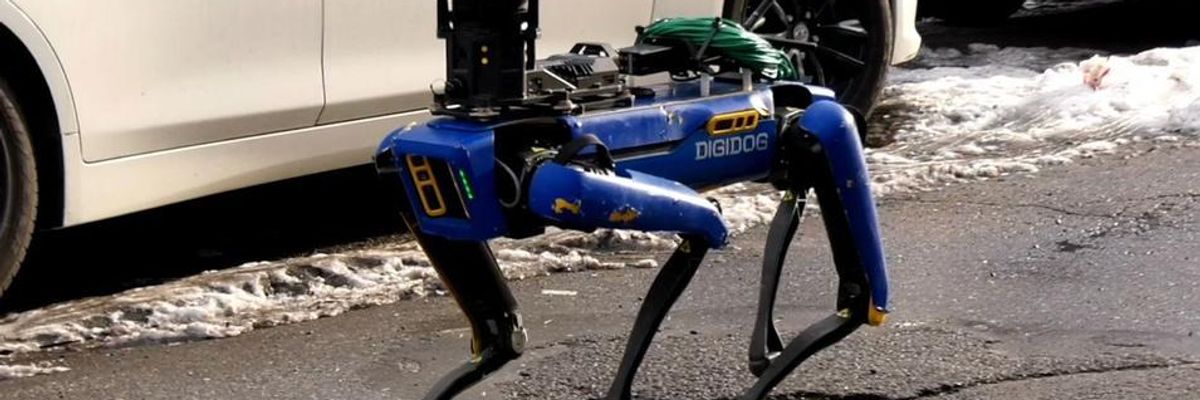
Rep. Alexandria Ocasio-Cortez (D-N.Y.) criticized the New York Police Department's deployment of a robotic K-9 unit to responde to a home invasion on February 23, 2021. (Photo: FNTV/YouTube screen grab)
Alexandria Ocasio-Cortez Condemns NYPD Test Deployment of K-9 Robot in Bronx Home
"Please ask yourself: when was the last time you saw next-generation, world class technology for education, healthcare, housing, etc. consistently prioritized for underserved communities like this?"
Arguing that money would be better spent on uplifting programs and policies rather than on high-tech policing of underserved communities, Rep. Alexandria Ocasio-Cortez on Thursday blasted the New York Police Department for deploying a robotic police dog in a Bronx apartment building earlier this week.
Responding to a New York Post article about the NYPD's use of a "DigiDog" robotic K-9 unit in response to a home invasion, Ocasio-Cortez (D-N.Y.) tweeted, "Shout out to everyone who fought against community advocates who demanded these resources go to investments like school counseling instead. Now robotic surveillance ground drones are being deployed for testing on low-income communities of color with under-resourced schools."
Minutes later, she tweeted, "Please ask yourself: when was the last time you saw next-generation, world class technology for education, healthcare, housing, etc. consistently prioritized for underserved communities like this?"
\u201cPlease ask yourself: when was the last time you saw next-generation, world class technology for education, healthcare, housing, etc consistently prioritized for underserved communities like this?\u201d— Alexandria Ocasio-Cortez (@Alexandria Ocasio-Cortez) 1614281512
Boston Dynamics, the manufacturer the "Spot" robot, advertises the 70-pound quadruped--which can run about three-and-a-half miles an hour and climb stairs--for $74,500, retail.
"Spot comes ready to operate, right out of the box," the company's website says. "With its flexible API [application programming interface] and payload interfaces, Spot can be customized for a variety of applications."
The NYPD version of the robot, which is still in its testing phase, is equipped with additional cameras and lights.
"This dog is going to save lives, protect people, and protect officers and that's our goal," NYPD Technical Assistance Response Unit Inspector Frank Digiacomo told WABC in December. "This robot is able to use its artificial intelligence to navigate things [in] very complex environments."
Boston Dynamics says it does not want Spot weaponized. And while the company says its robots aren't meant to kill people, it's easy to imagine how they could be customized or otherwise used to do just that. In 2016, Dallas police rigged a police bomb disposal robot with explosives to blow up a sniper who killed five officers.
\u201cBoston Dynamics\u2019 robot dog is now armed\u2014in the name of art. A group called MSCHF gave Spot a paintball gun and plan to let others remotely control it inside an art gallery.\n\nBut not everyone's laughing. Here's how the prank's sparked a kerfuffle: https://t.co/6YIyjDdeYq \ud83d\udcfd\ufe0f: MSCHF\u201d— WIRED (@WIRED) 1614048900
Matthew Guariglia, privacy policy analyst at the San Francisco-based digital rights advocacy group Electronic Frontier Foundation, wrote earlier this year that "the arrival of government-operated autonomous police robots does not look like predictions in science fiction movies."
"An army of robots with gun arms is not kicking down your door to arrest you," said Guariglia. "Instead, a robot snitch that looks like a rolling trash can is programmed to decide whether a person looks suspicious--and then call the human police on them." And while "police robots may not be able to hurt people like armed predator drones used in combat--yet--as history shows, calling the police on someone can prove equally deadly."
This is especially true given the well-documented algorithmic racial bias to which artificial intelligence is prone.
A more insidious threat of police robots, says Guariglia, involves surveillance.
"The next time you're at a protest and are relieved to see a robot rather than a baton-wielding officer, know that that robot may be using the IP address of your phone to identify your participation," he wrote. "This makes protesters vulnerable to reprisal from police and thus chills future exercise of constitutional rights."
An Urgent Message From Our Co-Founder
Dear Common Dreams reader, The U.S. is on a fast track to authoritarianism like nothing I've ever seen. Meanwhile, corporate news outlets are utterly capitulating to Trump, twisting their coverage to avoid drawing his ire while lining up to stuff cash in his pockets. That's why I believe that Common Dreams is doing the best and most consequential reporting that we've ever done. Our small but mighty team is a progressive reporting powerhouse, covering the news every day that the corporate media never will. Our mission has always been simple: To inform. To inspire. And to ignite change for the common good. Now here's the key piece that I want all our readers to understand: None of this would be possible without your financial support. That's not just some fundraising cliche. It's the absolute and literal truth. We don't accept corporate advertising and never will. We don't have a paywall because we don't think people should be blocked from critical news based on their ability to pay. Everything we do is funded by the donations of readers like you. Will you donate now to help power the nonprofit, independent reporting of Common Dreams? Thank you for being a vital member of our community. Together, we can keep independent journalism alive when it’s needed most. - Craig Brown, Co-founder |
Arguing that money would be better spent on uplifting programs and policies rather than on high-tech policing of underserved communities, Rep. Alexandria Ocasio-Cortez on Thursday blasted the New York Police Department for deploying a robotic police dog in a Bronx apartment building earlier this week.
Responding to a New York Post article about the NYPD's use of a "DigiDog" robotic K-9 unit in response to a home invasion, Ocasio-Cortez (D-N.Y.) tweeted, "Shout out to everyone who fought against community advocates who demanded these resources go to investments like school counseling instead. Now robotic surveillance ground drones are being deployed for testing on low-income communities of color with under-resourced schools."
Minutes later, she tweeted, "Please ask yourself: when was the last time you saw next-generation, world class technology for education, healthcare, housing, etc. consistently prioritized for underserved communities like this?"
\u201cPlease ask yourself: when was the last time you saw next-generation, world class technology for education, healthcare, housing, etc consistently prioritized for underserved communities like this?\u201d— Alexandria Ocasio-Cortez (@Alexandria Ocasio-Cortez) 1614281512
Boston Dynamics, the manufacturer the "Spot" robot, advertises the 70-pound quadruped--which can run about three-and-a-half miles an hour and climb stairs--for $74,500, retail.
"Spot comes ready to operate, right out of the box," the company's website says. "With its flexible API [application programming interface] and payload interfaces, Spot can be customized for a variety of applications."
The NYPD version of the robot, which is still in its testing phase, is equipped with additional cameras and lights.
"This dog is going to save lives, protect people, and protect officers and that's our goal," NYPD Technical Assistance Response Unit Inspector Frank Digiacomo told WABC in December. "This robot is able to use its artificial intelligence to navigate things [in] very complex environments."
Boston Dynamics says it does not want Spot weaponized. And while the company says its robots aren't meant to kill people, it's easy to imagine how they could be customized or otherwise used to do just that. In 2016, Dallas police rigged a police bomb disposal robot with explosives to blow up a sniper who killed five officers.
\u201cBoston Dynamics\u2019 robot dog is now armed\u2014in the name of art. A group called MSCHF gave Spot a paintball gun and plan to let others remotely control it inside an art gallery.\n\nBut not everyone's laughing. Here's how the prank's sparked a kerfuffle: https://t.co/6YIyjDdeYq \ud83d\udcfd\ufe0f: MSCHF\u201d— WIRED (@WIRED) 1614048900
Matthew Guariglia, privacy policy analyst at the San Francisco-based digital rights advocacy group Electronic Frontier Foundation, wrote earlier this year that "the arrival of government-operated autonomous police robots does not look like predictions in science fiction movies."
"An army of robots with gun arms is not kicking down your door to arrest you," said Guariglia. "Instead, a robot snitch that looks like a rolling trash can is programmed to decide whether a person looks suspicious--and then call the human police on them." And while "police robots may not be able to hurt people like armed predator drones used in combat--yet--as history shows, calling the police on someone can prove equally deadly."
This is especially true given the well-documented algorithmic racial bias to which artificial intelligence is prone.
A more insidious threat of police robots, says Guariglia, involves surveillance.
"The next time you're at a protest and are relieved to see a robot rather than a baton-wielding officer, know that that robot may be using the IP address of your phone to identify your participation," he wrote. "This makes protesters vulnerable to reprisal from police and thus chills future exercise of constitutional rights."
Arguing that money would be better spent on uplifting programs and policies rather than on high-tech policing of underserved communities, Rep. Alexandria Ocasio-Cortez on Thursday blasted the New York Police Department for deploying a robotic police dog in a Bronx apartment building earlier this week.
Responding to a New York Post article about the NYPD's use of a "DigiDog" robotic K-9 unit in response to a home invasion, Ocasio-Cortez (D-N.Y.) tweeted, "Shout out to everyone who fought against community advocates who demanded these resources go to investments like school counseling instead. Now robotic surveillance ground drones are being deployed for testing on low-income communities of color with under-resourced schools."
Minutes later, she tweeted, "Please ask yourself: when was the last time you saw next-generation, world class technology for education, healthcare, housing, etc. consistently prioritized for underserved communities like this?"
\u201cPlease ask yourself: when was the last time you saw next-generation, world class technology for education, healthcare, housing, etc consistently prioritized for underserved communities like this?\u201d— Alexandria Ocasio-Cortez (@Alexandria Ocasio-Cortez) 1614281512
Boston Dynamics, the manufacturer the "Spot" robot, advertises the 70-pound quadruped--which can run about three-and-a-half miles an hour and climb stairs--for $74,500, retail.
"Spot comes ready to operate, right out of the box," the company's website says. "With its flexible API [application programming interface] and payload interfaces, Spot can be customized for a variety of applications."
The NYPD version of the robot, which is still in its testing phase, is equipped with additional cameras and lights.
"This dog is going to save lives, protect people, and protect officers and that's our goal," NYPD Technical Assistance Response Unit Inspector Frank Digiacomo told WABC in December. "This robot is able to use its artificial intelligence to navigate things [in] very complex environments."
Boston Dynamics says it does not want Spot weaponized. And while the company says its robots aren't meant to kill people, it's easy to imagine how they could be customized or otherwise used to do just that. In 2016, Dallas police rigged a police bomb disposal robot with explosives to blow up a sniper who killed five officers.
\u201cBoston Dynamics\u2019 robot dog is now armed\u2014in the name of art. A group called MSCHF gave Spot a paintball gun and plan to let others remotely control it inside an art gallery.\n\nBut not everyone's laughing. Here's how the prank's sparked a kerfuffle: https://t.co/6YIyjDdeYq \ud83d\udcfd\ufe0f: MSCHF\u201d— WIRED (@WIRED) 1614048900
Matthew Guariglia, privacy policy analyst at the San Francisco-based digital rights advocacy group Electronic Frontier Foundation, wrote earlier this year that "the arrival of government-operated autonomous police robots does not look like predictions in science fiction movies."
"An army of robots with gun arms is not kicking down your door to arrest you," said Guariglia. "Instead, a robot snitch that looks like a rolling trash can is programmed to decide whether a person looks suspicious--and then call the human police on them." And while "police robots may not be able to hurt people like armed predator drones used in combat--yet--as history shows, calling the police on someone can prove equally deadly."
This is especially true given the well-documented algorithmic racial bias to which artificial intelligence is prone.
A more insidious threat of police robots, says Guariglia, involves surveillance.
"The next time you're at a protest and are relieved to see a robot rather than a baton-wielding officer, know that that robot may be using the IP address of your phone to identify your participation," he wrote. "This makes protesters vulnerable to reprisal from police and thus chills future exercise of constitutional rights."

